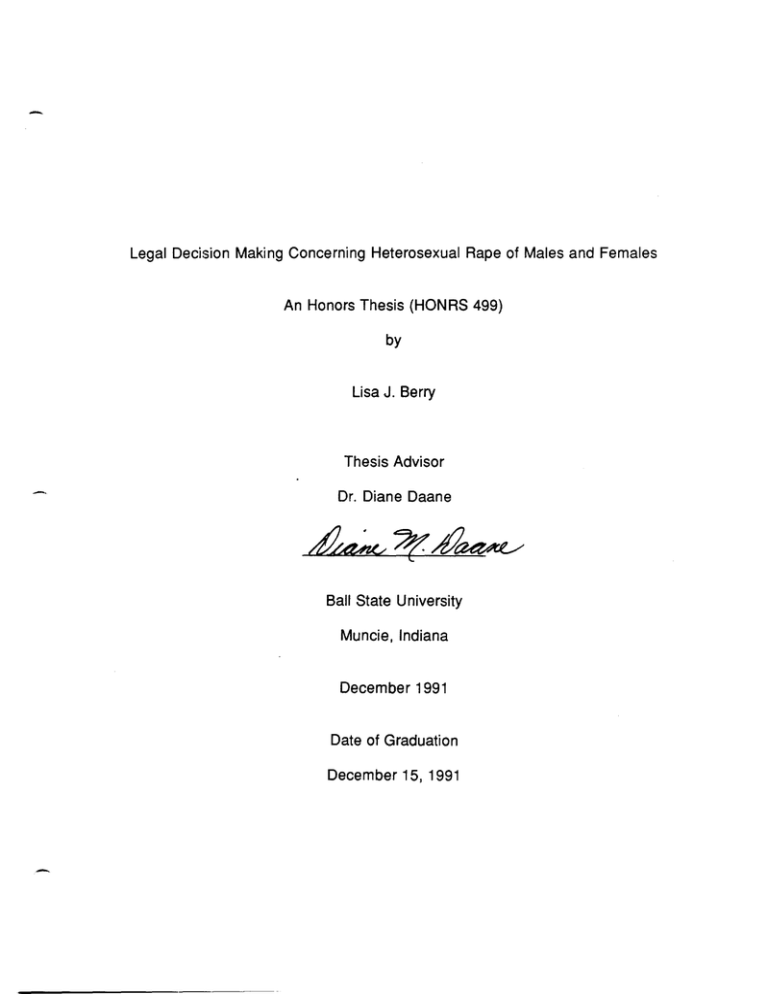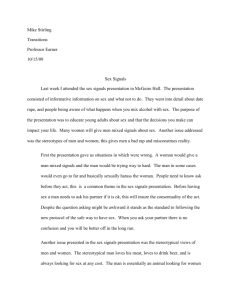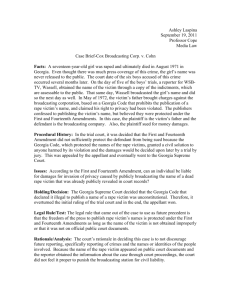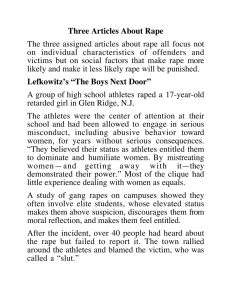
-
Legal Decision Making Concerning Heterosexual Aape of Males and Females
An Honors Thesis (HONAS 499)
by
Lisa J. Berry
Thesis Advisor
Dr. Diane Daane
Ball State University
Muncie, Indiana
December 1991
Date of Graduation
December 15, 1991
Abstract
This paper explores attitudes and stereotypes towards heterosexual rape of
males and females. A survey was administered to a group undergraduates at Ball
State University. It was anticipated that the subjects would find heterosexual rape of
males less believable and less likely to occur than heterosexual rape of females.
literature on male rape will also be reviewed.
-
The
-
In the past, there has been numerous publications on the subject of rape.
These publications have dealt primarily with the offender, the offense itself, and the
female victim. Although there has been increasing recognition of male rape victims,
these victims tend to be victims of homosexual assaults (Cotton and Groth, 1982;
Seabrook, 1990). Publications of anecdotal reports of men being forced by women
to participate in sexual acts occurred as early as 1952 (Lehfeldt). This subject of
male heterosexual rape has gotten little serious attention.
Male heterosexual rape is just as it sounds--a man is raped by a woman.
Masters has argued that the term "rape" should not be used in a case where a man is
forced by a woman to participate in sexual acts.
His arguments are that our society
associates rape with the female sex and that during rape the victim's body is invaded
by the attacker (1986). This researcher will be using the term "rape" as defined by
Benedict as any sexual act that is forced upon a person (1985).
Our culture has the belief that a man must be sexually aroused in order to
have an erection. Studies are finding that a man can respond sexually during a
variety of intense emotions ranging from anger to fear to embarrassment
(Calderwood, 1987; Masters, 1986; Sarrel and Masters, 1982). Sarrel, Masters, and
The Johnson Institute found in their study of men who were raped by women that all
nineteen of the victims had erections and six of them ejaculated (as cited in Benedict,
1985).
Due to the fact that a woman who has raped a man has not been
interviewed, researchers can only theorize about the motivation. The basic theory is
that of a parallel between male and female offenders. The major motive for the rapist
is the need to control, to overpower, to humiliate, and to hurt the victim. The act of
-
rape is a way to achieve such power (Benedict, 1985; Masters, 1986).
There are many influences in the way SOCiety judges rape, rapists, and rape
victims. These influencing factors are stereotypes and myths about rape. These
myths and stereotypes range from the belief that rape is sex, to the belief that women
provoke rape (Benedict,1985). Myths and stereotypes that affect the way society
views male rape are the belief that men are more sexually oriented and the belief
that men are more interested in sex for its own sake (Smith, Pine, and Hawley, 1988).
The majority of the research on stereotypes and myths about rape are
concerned with the reactions to female victims. A study by Smith, Pine, and Hawley
researched the social cognitions about the male victims of female sexual assault. It
was found that that the male victim of a sexual assault by female offenders was
judged more likely to have encouraged the episode, to have derived more pleasure
from it, and to have experienced less stress (1988).
The legal system in the U.S. in many ways is affected by these same
stereotypes and myths. For years, the Hale Instruction was given to juries warning
-
them that a woman who has accused a man of rape may be doing so because she is
jealous, angry, or hurt. Even today, the action of the victim is judged, not the action of
the attacker. In order for the act to be considered rape and not consent, the victim
must exert earnest resistance against the attacker. The focus is on the victim's
conduct not the attackers (Daane, 1988).
Males may face even worse prejudice in the U.S. legal system. Thirty-nine
states have gender neutral laws, but eleven states still have gender specific statutory
rape laws. As far as it is known, no male rape victim has won in court. Attorneys may
even show prejudices against their male clients. Sarrel was quoted as knowing of
two male rape victims who were not believed by their attorneys. This disbelief was
due to the myth that men cannot respond sexually unless aroused (Petrucelli, 1982).
Due to these reported prejudices in the U.S. legal system, this researcher
decided to investigate the myths and stereotypes as they might affect those who sit
-
as jurors on a rape trial. To study these prejudices about male heterosexual rape, a
legal decision survey was administered. It was anticipated that the subjects
surveyed would find heterosexual male rape less believable and less likely to occur.
It was hypothesized that this survey would more specifically show heterosexual male
rape to be encouraged by the male victim instead of forced by the offender, and
sexually pleasurable for the male victim. It was expected that of these afore
mentioned factors, female defendants would be found less guilty and would
generally be given shorter sentences than male defendants.
Method
Subjects
Ball State University undergraduates were used as the subjects in this
research. There were 135 male subjects and 101 female subjects. These
undergraduates were enrolled in introductory and upper level criminal justice
courses.
Procedure
The subjects were enrolled in three different criminal justice classes at Ball
State University and participated on a voluntary basis. This researcher informed the
subjects that they would be given a randomly selected court case and it may not be
an Indiana case. This instruction was given because the case scenario used in the
survey in Indiana law would not be rape, but sexual deviate conduct. The subjects
were then instructed to read the case scenario carefully and to answer the legal
decision making questions following it. The subjects were asked to make serious
judgments as if they were the actual jurors in this case.
This researcher then gave each subject a survey containing one case
scenario and a series of questions. The surveys were prearranged in order so that
there would be a similar number of both surveys taken and to prevent the subjects
from realizing that there were two surveys. The subjects were also instructed to
remain quiet so not to influence others taking the survey. It was hoped that this
instruction would lower the number of subjects discovering that there were two
,-
surveys circulating.
Survey
The survey administered was designed by Smith, Pine, and Hawley for their
1988 research "Social Cognitions About Adult Male Victims of Female Sexual
Assault". The survey used was of a 2 (sex of victim) X 2 (sex of respondent) factorial
analysis design. The case scenario in the survey was entitled "Barnett/Dandridge v.
State of Washington" and was as follows:
On Tuesday, May 10, 1977, John (or Joan) Drucker, a 20 year-old college
student, was traveling on U.S. Route 2 west of Leavenworth, Washington.
On a relatively deserted stretch of highway, Mr. (Ms.) Drucker's
auto overheated as the result of a broken fan belt. He (she) was offered
and accepted a ride to a service station in the next town by the
defendants, Mary (Mark) Barnett and Theresa (Thomas) Dandridge.
According to Mr. (Ms.) Drucker, the defendants suddenly pulled off the
highway onto a deserted dirt road and confronted him (her) with a gun.
Mr. (Ms. ) Drucker stated that he (she) was forced to disrobe and the
defendants did likewise. Mr. (Ms.) Drucker was then told by Ms. (Mr.)
Dandridge that he (she) and the defendants were going to "playa little
game called '69'". For the next thirty minutes, Mr. (Ms.) Drucker stated
that he (she) was forced to engage with the two women (men) in mutual
oral-genital sexual activity. He (she) stated that he (she) was left in the
deserted field with his (her) clothes as the defendants drove off. He (she)
made his (her) way to the highway and was eventually picked up by the
State Patrol, to whom he (she) reported the incident.
The defendants were apprehended later that day in Skykomish, Washington.
They were positively identified by Mr. (Ms.) Drucker. A gun was found
in their possession and identified by Mr. (Ms.) Drucker as the weapon
used in the episode.
Mr. (Ms.) Drucker preferred charges, and under Washington law, the
defendants were charged with rape, an offense punishable by a prison term of
5 to 20 years.
At the trial held in Wenatchee, Washington, the defendants acknowledged
that the alleged sexual acts had occurred, but they denied that they forced
Mr. (Ms. ) Drucker to engage in them. They claimed, instead, that the sexual
incident occurred at the suggestion of Mr. (Ms. ) Drucker.
The series of questions were as follows:
1. What is your judgment of the innocence or guilt of the defendants? (Answered
on a 7-point Likert format ranging from 1, I am certain they are innocent, to 7,
I am certain they are guilty.)
2. The crime of rape is punishable by a term of 5 to 20 years in prison. If you
found the defendants guilty, how many years' imprisonment would you
recommend? (Subject wrote number.)
3. What is your judgment of the likelihood that Mr. (Ms.) Drucker was forced by
the defendants to engage in the sex acts? (Answered on a 6-point scale ranging
from extremely likely to extremely unlikely.)
4. What is your judgment of the likelihood that, as the defendants claim, Mr.
(Ms.) Drucker encouraged or initiated the sex acts? (6-point scale from
extremely likely to extremely unlikely.)
5. How sexually pleasurable do you feel the incident was for the two defendants?
( 6-point scale from extremely pleasurable to extremely unpleasurable.)
6. How sexually pleasurable do you feel the incident was for Mr. (Ms.) Drucker?
(Same scale as item 5.)
7. How stressful do you feel the incident was for Mr. (Ms.) Drucker? (6-point
scale ranging from extremely stressful to not at all stressful.)
8. How personally responsible do you feel Mr. (Ms.) Drucker was for the sexual
episode that occurred? (6-point scale from completely responsible and not at all
responsible.)
Results
Using a 2 (sex of victim) x 2 (sex of respondent) design on the 5P55
MANOVA, a multivariate analysis of variance was performed on the
specific dependent variables. An alpha level of .05 was chosen to be the constant
indicator of significant difference between the cell means. For the focus of the
research, six dependent variables will be used to discuss verdicts, punishments, and
victim responsibility.
The first issue to be discussed is verdicts. The dependent variable
associated with this issue is question one on the survey in regards to innocence or
guilt of the defendants. The mean for the entire sample was 5.747 showing that as a
whole, the group found the defendants guilty. A difference was however found in the
degree of certainty of guilt based on the sex of the victim and also based on the
gender of the respondent, but an interaction effect between the two was not found.
For female victims, male respondents degree of certainty (M=5.638, 50=1.236) was
lower than female respondents degree of certainty (M=6.320, 50=.913). For male
victims, male respondents degree of certainty (M=5.464, 50=1.206) was also lower
than the degree of certainty (M=5.640, 50=1.274) shown by female respondents. A
-
significant difference was seen between male and female respondents regardless of
the victim's sex, F=7.39, p=.007. The victim's sex ignoring the gender of the
respondent was also found to be significant, F=7.31, p=.007.
The next issue to be discussed is the punishments. The dependent
variable associated with this issue is question two in regards to years sentenced. For
female victims, female respondents gave a slightly lesser sentence (M=14.380,
50=5.158) than did male respondents
(M=14.424, 50=5.646). For male victims,
female respondents were higher (M=11.000, 50=5.403) than male respondents
(M=9.962, 50=5.481). The only significant difference seen was in the victim's sex
ignoring gender of the respondent, F=27.61, p=.OOO.
Figure 1
~udgmtnt
Condition
n
VmM
Malts
Innoctnce or
n
(Years)
Guilt
56
M 5.464
52
SO 1.206
Ftmales
50
Senttncing
M 5.640
48
SO 1.274
M
9.962
SO
5.481
M 11.000
SO
5.403
VfAm
M~l.s
69
M 5.638
66
SO 1.236
Females
50
M 6.320
SO
.913
M 14.424
SO
50
5.646
H 14.380
SO
5.158
The third issue to be discussed is victim responsibility. The dependent
variables associated with this issue are questions three, four, six, and eight regarding
--
force, victim encouragement, victim pleasure, and victim responsibility. Means and
standard deviations for these cells are shown in Figure 2. Oependent variable
(question three), in regard to force, found a significant difference based on the
victim's sex regardless of respondent gender, F=32.57, p=.OOO. For the female
victim, female respondents were more likely to judge the victim as being forced
(M=1.820, 80=1.480) than male respondents (M=2.191, 80=1.374).
For male victims, female respondents were also more likely to judge the victim as
being forced (M=3.041, 80=1.607) than male respondents (M=3.309, 80=1.620).
Oependent variable (question four), in regard to victim encouragement, found a
significant difference based on gender of the respondent, F= 11.58, p=.001 and also
based on victim's sex, F=27.38, p=.OOO. For female victims, female respondents
judged the victim less likely to have encouraged the episode (M=5.608, 80=.802)
-
than male respondents (M=4.826, 80=1.328). For male victims, female respondents
also judged the victim less likely to have encouraged the episode (M=4.520,
80=1.297) than male respondents (M=4.164, 80=1.411).
Oependent variable
(question six), in regard to victim pleasure, found a significant difference based on
gender of the respondent, F=28.98, p=.OOO and also based on the victim sex,
F=56.13, p=.OOO. For female victims, the female respondents judged the episode
less sexually pleasurable for the victim (M=5.765, 80=.619) than male respondents
(M=4.739, 80=1.668). For male victims, the female respondents also judged the
episode as less sexually pleasurable for the victim (M=4.327, 80=1.676) than male
respondents (M=3.246, 80=1.515). Dependent variable (question eight), in regard
to victim responsibility, found a significant difference based on the gender of the
respondent, F=5.76, p=.017. For female victims, the female respondents judged the
victim as less responsible for the episode (M=5.157, 80=.946) than male
-
respondents (M=4.435, 80=1.430). For male victims, the female respondents also
judged the victim as less responsible for the episode (M=4.600, 80=1.414) than
male respondents (M=4.482, 80=1.321).
-
Figur@ 2
Judgment
n
I
I
I
Victim
I
Responsibility I
56
M
i
Condition
n
Force
55
M
Vm At
Males
3.309
I
I
I n
I
I
!
55
49
M
3.041
n
Victim
Pleasure
4.164
57
M
M
50
M
4.520
49
SD 1.297
SD 1.607
3.246
SD 1.515
SD 1 .411
SD 1.620
Females
Victim
Encour ag@ment
M
4.327
4.482
SD 1.321
50
M
4.600
SD 1.414
I SD 1.676
Vf Am
Males
68
M
2.191
69
50
M
1.820
SD 1.480
-
4.826
69
51
M
SD
5.608
.802
M
4.739
69
SD 1.668
SD 1.328
SD 1.374
Femal@s
M
51
M
SD
5.765
.619
M
4.435
SD 1.430
51
M
SO
5.157
.946
Discussion
The results of this research demonstrate that stereotypes and myths do
affect potential jurors of a rape case. These jurors are especially affected by
stereotypes and myths when the victim of that rape case is male. The male victim of
rape was judged as more likely to have encouraged the episode, less likely to have
been forced, and to have derived more pleasure from the episode. The male
respondents were more pronounced in their judgments. It is believed that the
judgments were more pronounced due to the disbelief that a woman could
overpower and take control of a man. The factor being overlooked is the use of a
weapon. In the survey, there were two females and a gun. This is typical of male
heterosexual rape. The female rapist usually attacks with a group of women or with a
weapon. These factors are great equalizers (Benedict, 1985).
Two women dominating a man sexually is also seen by many men as a
fantasy rather than a crime. Smith, Pine, and Hawley quoted one of their male
subjects as writing "Some guys have all the luck!" (1988). In response to the survey
given, one male respondent wrote that "Since they raped a guy, he probably enjoyed
it." In general, the male respondents are overlooking the trauma suffering by the
male victim. The male victim of heterosexual rape is not an active and willing
participant as in the case of any rape victim.
The myth that rape is sex was also seen in the surveys completed by the
male respondents. The same male respondent in this research also questioned the
physical attractiveness of the attackers. He stated that "No guy wants to have sex if
she (the attacker) looks like s---.". This shows the acceptance of the myths that males
are interested in sex for its own sake and are more sexually oriented (Smith, Pine,
and Hawley, 1988).
Women respondents were less pronounced in their judgments of male
heterosexual rape victims. It is believed that their judgments were more empathetic
due to the conditioning of women to fear attack. One respondent gave constructive
criticism by stating "She (the victim) should not have gotten in a car with a strange
man.". This statement may have been the result of classroom or parental education.
This education is more often directed toward females than males.
There is a need for more awareness of rape as a crime in society.
The male victims need to be aware of their own myths and stereotypes that might
prevent them from reporting an attack or seeking professional help in recovering from
an attack. The victim needs to seek support and treatment parallel to that of female
victims.
The myths and stereotypes concerning rape need to be studied and
understood in order for them to be eliminated. Until this awareness takes place on
society as a whole, professional people (doctors, lawyers, counselors, judges, etc.)
need to be aware that heterosexual rape of males occurs and is traumatic and
-
debilitating. "It has taken 20 years for female victims of sexual assault to be taken
seriously, we are now at that stage with males. (Nigel O'Mara as cited in Seabrook,
1990).
.References
Benedict, H. (1985). Recovery. Doubleday and Company, New York.
Calderwood, D. (1987). The Male Rape Victim. Medical Aspects of Human
Sexuality, 21, 53-55.
Cotton, D.J., and Groth, A. N. (1982). Inmate Rape: Prevention and intervention.
Journal 01' Prison and Jail Health, 2 (1), 47-57.
Daane, D. (1988). Rape Law Reform: How Far Have We Come? The Prison
Journal. 118, 3-10.
Lehfeldt, H.
(19~;2).
Unusual "sex crime". Journal of Sex Education, 4, 176.
Masters, W.H. (1986). Sexual Dysfunction as as Aftermath of Sexual Assault of Men
by Women. Journal of Sex and Marital Therapy, 12, 35-44.
Petrucelli, A.W. (1982, November 23). Reverse Rape. Us, pp. 68-69.
Sarrel, P., and Masters, W.H. (1982). Sexual Molestation of Men by Women.
Archives of Sexual Behavior, 11, 117-131.
Seabrook, J. (1990). Power Lust. New Statesman and Society, 3, 20-23.
Smith, R.E., PinEl, C.J., and Hawley, M.E. (1988). Social Cognitions about Adult Male
Victims of Female Sexual Assault. Journal of Sex Research, 24, 101-112.






